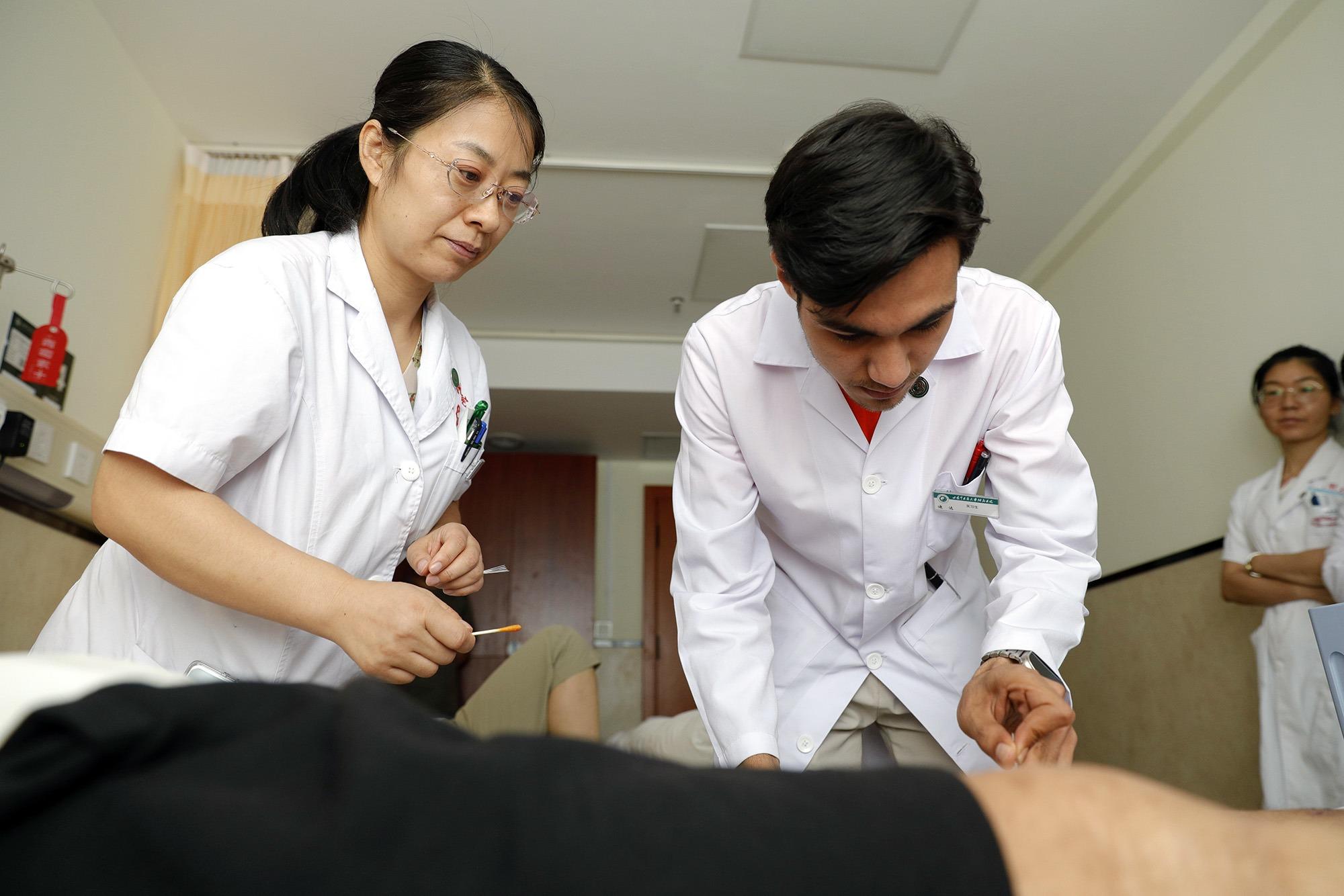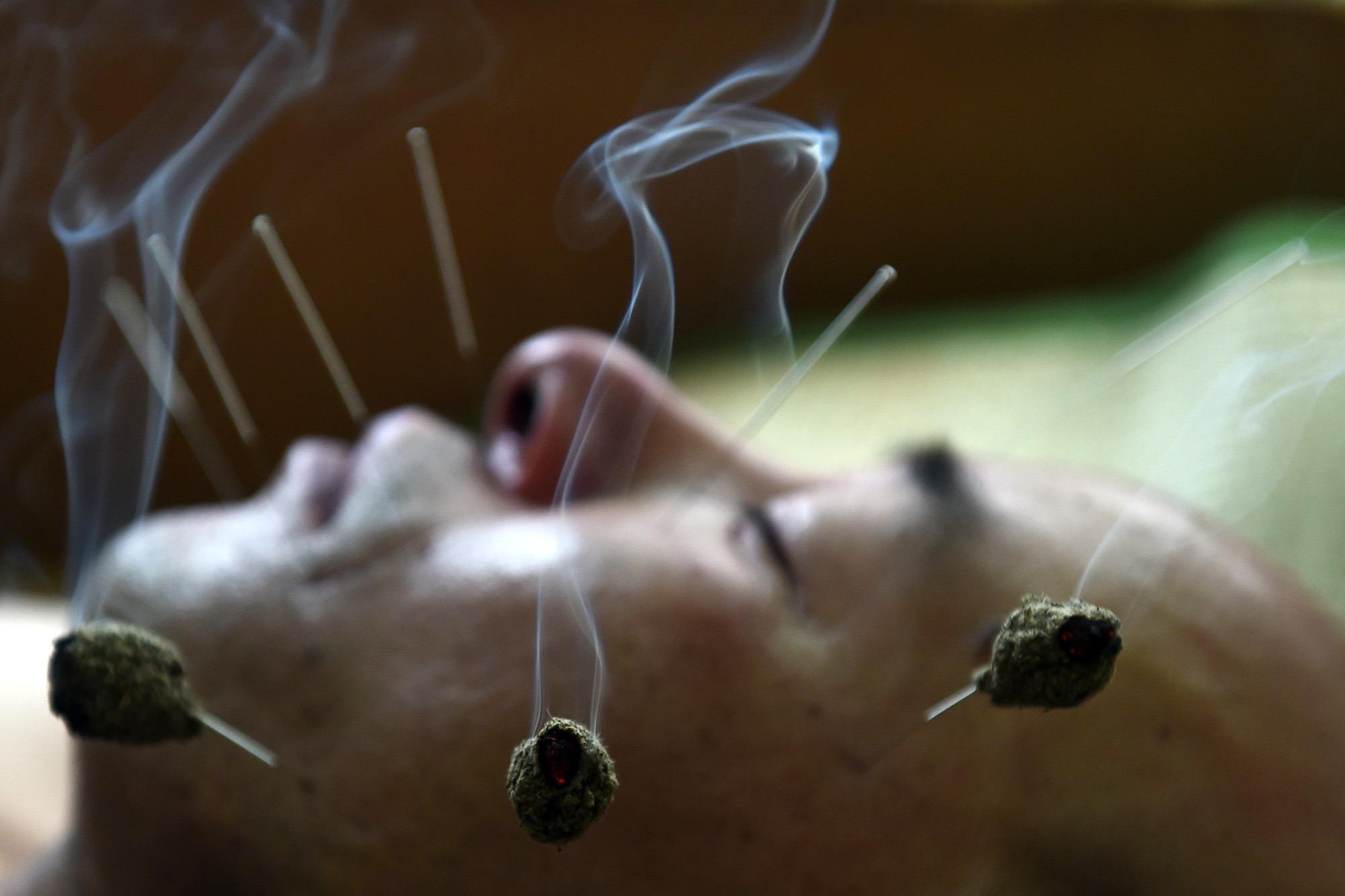As research expands scientific basis for ancient technique, global recognition is rising, as is interest in finding new applications, Yang Yang reports.
 A foreign student practices acupuncture in a hospital in Lanzhou, Gansu province. (PHOTO / XINHUA)
A foreign student practices acupuncture in a hospital in Lanzhou, Gansu province. (PHOTO / XINHUA)
Editor's note: There are 43 items inscribed on UNESCO's Intangible Cultural Heritage lists that not only bear witness to the past glories of Chinese civilization, but also continue to shine today. China Daily looks at the protection and inheritance of some of these cultural legacies. In this installment, we find out how an ancient healing art has gained increasing popularity in modern times.
For thousands of years, the Chinese have relieved pain and cured disease through acupuncture. Evolving from the discovery that using stone needles to prick specific points on the surface of the body could relieve pain and symptoms, acupuncture has become an integral part of traditional Chinese medicine, in line with the philosophy that promotes the harmonious coexistence of humans with nature.
According to Records of the Grand Historian, written by Sima Qian about 2,100 years ago, Bian Que, a highly skilled physician during the Warring States Period (475-221 BC), was famous for having saved a prince from "death" by using needles to stimulate the Baihui acupoint on the head of the unconscious man.
According to TCM, there are a dozen meridians in the human body, where the qi, or life energy, circulates to nourish the organs. Cold, infections or diseases can result in the blocking of the energy, and so stimulating the acupoints can unblock stagnant qi, restore normal circulation and improve health.
Today, acupuncture is still widely used in China.
Li Ming, a 41-year-old who works in media, says that acupuncture really helped treat the dry eyes she had been suffering from since 2009. After trying many other ways, a friend suggested she turn to a doctor at Beijing Tongren Hospital who excelled in treating the condition with acupuncture.
Li's treatment lasted one and a half years, and after more than 130 visits, her symptoms significantly decreased, and her eyes became moist enough for her to resume work in 2013.
Liu Cunzhi, head of the School of Acupuncture, Moxibustion and Tuina at the Beijing University of Chinese Medicine, says that he has been using acupuncture to treat patients at the first stage of Alzheimer's disease. "Many of my patients come to me twice a week for seven or eight years to maintain their current condition," he says.
In 2010, UNESCO inscribed acupuncture and moxibustion of TCM on the Representative List of Intangible Cultural Heritage of Humanity. Yet, the practice is not just cultural and historical, but also a medical technique widely used and researched today.
For years, despite the clear therapeutic effects of acupuncture in treating many diseases, there were few convincing studies that explained how acupoint stimulation worked, or what meridians were anatomically speaking, so the technique always seemed somewhat mysterious.
However, as scientific research of acupuncture has grown in recent years, producing better quality results, the technique is gaining traction around the world.
One debate revolves around the foundation of acupuncture — the question of whether meridians actually exist.
Yang Shengya, director of the Department of Acupuncture and Moxibustion at the Beijing Massage Hospital, explains that meridians are more of a functional concept than a concrete anatomic structure.
"The qi and blood only run in meridians in a living person. When a person dies, there is no qi and blood does not circulate anymore, so comparing meridians to vessels or nerves is not accurate," Yang says.
"From the perspective of clinical practice, meridians describe the function of pathways through the human body. Once a person dies, the function ends immediately.
"Maybe in the future, we will be able to explain what meridians are exactly. But, just because you cannot see something, that doesn't mean it doesn't exist."
Liu echoes Yang's opinion, saying that studies of the anatomic structure of meridians lead nowhere, so now many researchers are trying to explain the mechanisms of acupuncture, instead — such as why pricking the acupoints on the face can relieve toothache.
 Acupuncture and moxibustion, treatments of traditional Chinese medicine, have won increasing recognition throughout the world since they were inscribed on the Representative List of Intangible Cultural Heritage of Humanity by UNESCO in 2010. (HE DONGPING / ZHU JUN / FOR CHINA DAILY)
Acupuncture and moxibustion, treatments of traditional Chinese medicine, have won increasing recognition throughout the world since they were inscribed on the Representative List of Intangible Cultural Heritage of Humanity by UNESCO in 2010. (HE DONGPING / ZHU JUN / FOR CHINA DAILY)
Solid studies
Through studies conducted over the last century, scholars now have a relatively deep understanding of the working mechanisms of acupuncture, says Jing Xianghong, director of the Institute of Acupuncture and Moxibustion at the China Academy of Chinese Medical Sciences.
Chinese scientists have accumulated a great deal of information in the study of acupuncture analgesia, the sensitization of acupoints, and the effects of acupoint stimulation, she adds.
In TCM, acupoints reflect the body's internal condition. When diseased or injured, corresponding acupoints become sensitized, displaying effects like expanded receptive fields, heightened pain perception, and increased heat sensitivity, which gradually disappear as the body heals.
In 2021, Ma Qiufu, a professor at Harvard University, co-authored a paper, titled A Neuroanatomical Basis for Electroacupuncture to Drive the Vagal-Adrenal Axis, with researchers from China including Jing, which was published in the journal Nature.
Since then, basic scientific research on acupuncture and moxibustion has once again drawn the attention of researchers, Jing says.
She adds that, based on existing studies, it is possible to conclude that the transmission and integration of the nervous system are essential for acupuncture to work. The neuroendocrine-immune network serves as the primary carrier for acupuncture's modulating effects, and molecular biology provides the material basis for explaining the effects of acupuncture.
In simpler words, the studies show that the nervous system plays a crucial role in acupuncture. It relies on a network that involves the nervous system, hormones, and the immune system. Molecular biology also helps explain how acupuncture works.
Last year, professor Xu Nenggui and a research team from the Guangzhou University of Chinese Medicine published Evidence Mapping and Overview of Systematic Reviews of the Effects of Acupuncture Therapies in the British Medical Journal.
The study established the most comprehensive database and data matrix for acupuncture clinical effectiveness research to date, and recalculated the effect values of acupuncture for each disease. The paper suggests which diseases and conditions acupuncture can substantially benefit and which show promise but still require further study, says Lu Liming, who was part of the team.
Xu says the study can help acupuncturists and researchers make decisions quickly in clinical practice and research.
Liu says acupuncture's advantages lie in the fact that it is an external technique, so it is safer than taking medicine, and is effective in treating many conditions.
According to the study by Xu and his colleagues, acupuncture can substantially benefit post-stroke aphasia, neck and shoulder pain, fibromyalgia, nonspecific lower back pain, vascular dementia, postpartum lactation insufficiency and allergic rhinitis.
Yang is working on the research into the therapeutic effect of acupuncture for benign paroxysmal positional vertigo, a common inner ear condition causing sudden and intense dizziness triggered by movements of the head. The condition is caused by small ear crystals that have become dislodged. He found that after the treatment commonly used to reposition the crystals, five rounds of acupuncture can effectively reduce remaining dizziness, as well as relieve anxiety about any sudden reoccurrence.
In addition, based on strict randomized controlled trials conducted by researchers around the world, acupuncture has been found effective in treating conditions such as chronic severe functional constipation, female stress urinary incontinence, and migraine, Jing says.
 Acupuncture and moxibustion, treatments of traditional Chinese medicine, have won increasing recognition throughout the world since they were inscribed on the Representative List of Intangible Cultural Heritage of Humanity by UNESCO in 2010. (HE DONGPING / ZHU JUN / FOR CHINA DAILY)
Acupuncture and moxibustion, treatments of traditional Chinese medicine, have won increasing recognition throughout the world since they were inscribed on the Representative List of Intangible Cultural Heritage of Humanity by UNESCO in 2010. (HE DONGPING / ZHU JUN / FOR CHINA DAILY)
Increasing popularity
According to a report by the World Health Organization, acupuncture is the most widely used traditional medicine practice globally.
Between 2002 and 2012, patients receiving acupuncture and the number of licensed acupuncturists grew by 50 percent and 100 percent respectively in the United States, Jing says.
Currently, it is used in 183 countries and regions, and 59 have licensed it legally, according to a development report on acupuncture as a discipline between 2013 and 2020, compiled by the China Association of Acupuncture-Moxibustion.
In clinical practice guides from more than 40 countries and regions, including the US, the United Kingdom and Japan, acupuncture is one of the recommended therapies for certain diseases and for conditions like pain and depression, according to the report.
A report in Time magazine last year said that acupuncture is gaining traction in the US, as more evidence shows that acupuncture is effective, especially in conditions that have become chronic.
Contact the writer at yangyangs@chinadaily.com.cn


